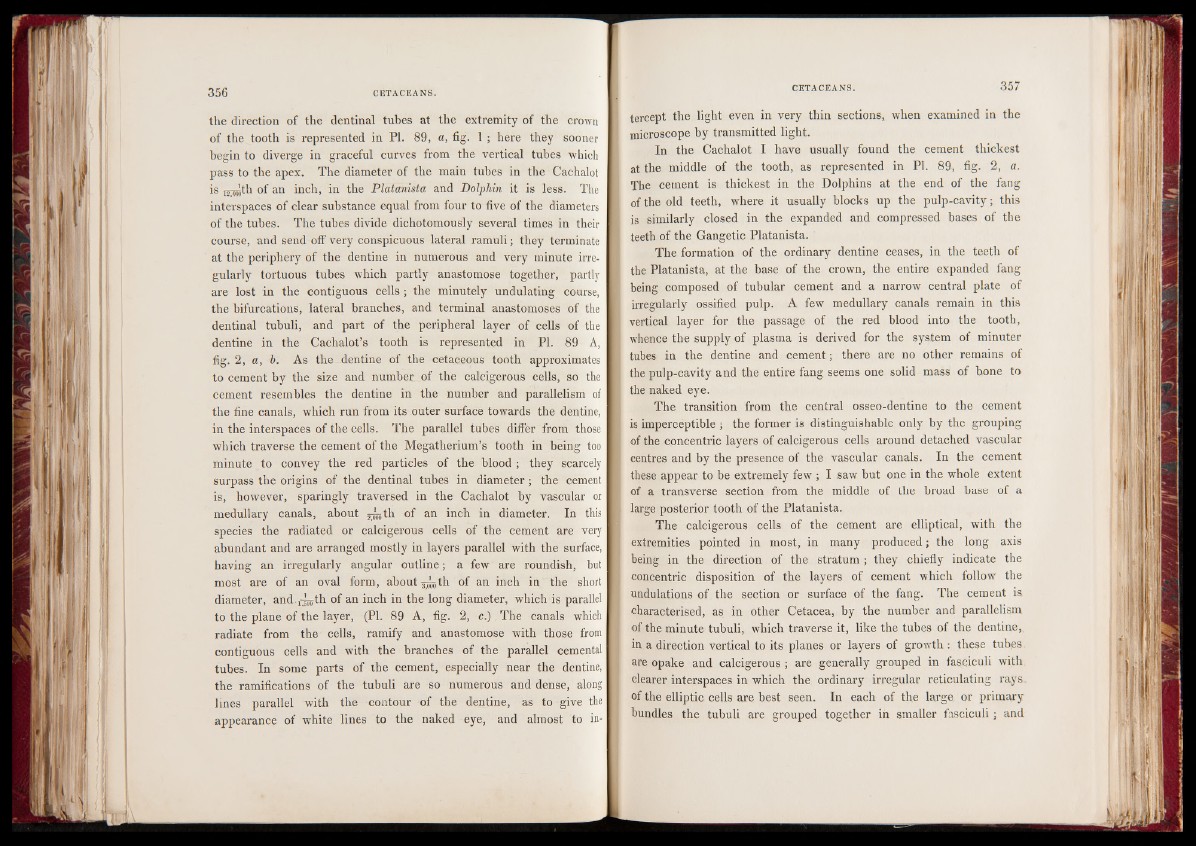
356 CETACEANS.
the direction of the dentinal tubes at the extremity of the crown
of the tooth is represented in PI. 89, a, fig. 1 ; here they sooner
begin to diverge in graceful curves from the vertical tubes which
pass to the apex. The diameter of the main tubes in the Cachalot
is jposth of an inch, in the Platanista and Dolphin it is less. The
interspaces of clear substance equal from four to five of the diameters
of the tubes. The tubes divide dichotomously several times in their
course, and send off very conspicuous lateral ramuli; they terminate
at the periphery of the dentine in numerous and very minute irregularly
tortuous tubes which partly anastomose together, partly
are lost in the contiguous cells; the minutely undulating course,
the bifurcations, lateral branches, and terminal anastomoses of the
dentinal tubuli, and part of the peripheral layer of cells of the
dentine in the Cachalot’s tooth is represented in PI. 89 A,
fig. 2, a, h. As the dentine of the cetaceous tooth approximates
to cement by the size and number of the calcigerous cells, so the
cement resembles the dentine in the number and parallelism of
the fine canals, which run from its outer surface towards the dentine,
in the interspaces of the cells. The parallel tubes differ from those
which traverse the cement of the Megatherium’s tooth in being too
minute to convey the red particles of the blood ; they scarcely
surpass the origins of the dentinal tubes in diameter; the cement
is, however, sparingly traversed in the Cachalot by vascular or
medullary canals, about p^th of an inch in diameter. In this
species the radiated or calcigerous cells of the cement are very
abundant and are arranged mostly in layers parallel with the surface,
having an irregularly angular outline; a few are roundish, but
most are of an oval form, about ^ t h of an inch in the short
diameter, and.jjijoth of an inch in the long diameter, which is parallel
to the plane of the layer, (PI. 89 A, fig. 2, c.), The canals which
radiate from the cells, ramify and anastomose with those from
contiguous cells and with the branches of the parallel cemental
tubes. In some parts of the cement, especially near the dentine,
the ramifications of the tubuli are so numerous and dense, along
lines parallel with the contour of the dentine, as to give the
appearance of white lines to the naked eye, and almost to inCETACEANS.
357
tercept the light even in very thin sections, when examined in the
microscope by transmitted light.
In the Cachalot I have usually found the cement thickest
at the middle of the tooth, as represented in PI. 89, fig. 2, a.
The cement is thickest in the Dolphins at the end of the fang
of the old teeth, where it usually blocks up the pulp-cavity; this
is similarly closed in the expanded and compressed bases of the
teeth of the Gangetic Platanista.
The formation of the ordinary dentine ceases, in the teeth of
the Platanista, at the base of the crown, the entire expanded fang
being composed of tubular cement and a narrow central plate of
irregularly ossified pulp. A few medullary canals remain in this
vertical layer for the passage of the red blood into the tooth,
whence the supply of plasma is derived for the system of minuter
tubes in the dentine and cement ; there are no other remains of
the pulp-cavity and the entire fang seems one solid mass of bone to
the naked eye.
The transition from the central osseo-dentine to the cement
is imperceptible ; the former is distinguishable only by the grouping
of the concentric layers of calcigerous cells around detached vascular
centres and by the presence of the vascular canals. In the cement
these appear to be extremely few ; I saw but one in the whole extent
of a transverse section from the middle of the broad base of a
large posterior tooth of the Platanista.
The calcigerous cells of the cement are elliptical, with the
extremities pointed in most, in many produced ; the long axis
being in the direction of the stratum ; they chiefly indicate the
concentric disposition of the layers of cement which follow the
undulations of the section or surface of the fang. The cement is
characterised, as in other Cetacea, by the number and parallelism
of the minute tubuli, which traverse it, like the tubes of the dentine,,
in a direction vertical to its planes or layers of growth : these tub.es.
are opake and calcigerous ; are generally grouped in fasciculi with
clearer interspaces in which the ordinary irregular reticulating rays,
of the elliptic cells are best seen. In each of the large or primary
bundles the tubuli are grouped together in smaller fasciculi ; and